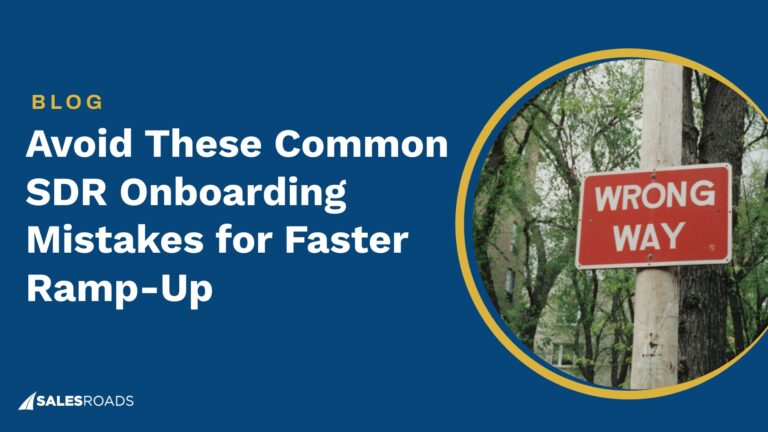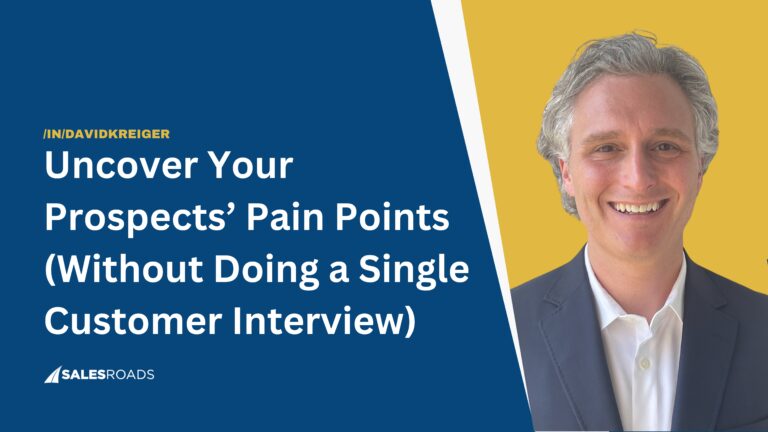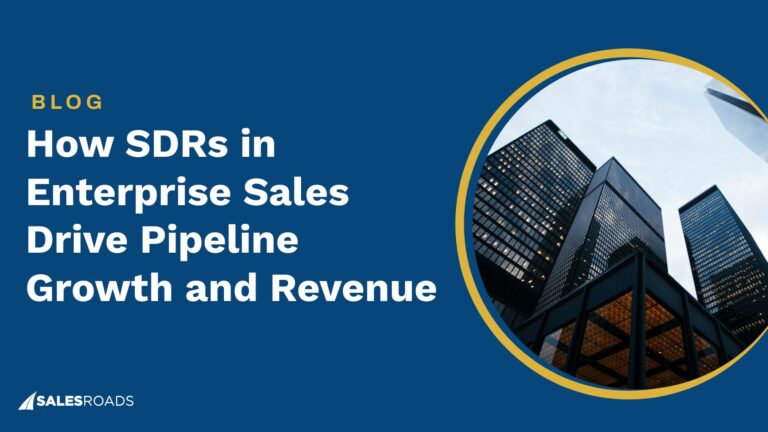Sell Like A Leader – Episode 24
In this episode, we dive into:
– Transitioning to management role: Mentorship and learning from thought leaders, focusing on team development, development of coaching and leadership mindset, reducing micromanagement, understanding your team’s current capabilities, developing a performance framework, creating a transparent motivational environment, implementing data-driven decision-making, and fostering a continuous learning culture.
– Rapid fire Q&A
About Mitchell Kasprzyk
David Kreiger chats with Mitchell Kasprzyk, the VP of Sales at Compyl. He has driven growth across SaaS startups and enterprise organizations by shifting from traditional selling to a consultative approach that helps buyers make meaningful progress.
Podcast Key Takeaways
- Mitchell stresses the importance of evaluating your sales team’s current capabilities. He highlights the value of data-driven diagnostics, like in-depth win-loss analyses, to identify patterns and gain a clearer picture of team performance.
- Get the “pipeline math” right. Since every salesperson has a different closing rate, their pipeline coverage targets should be customized accordingly. This tailored approach makes it easier to track individual performance and provide the right level of support.
- Lead by example and use structured updates to make team meetings more efficient and impactful. This not only saves time but also builds trust and keeps the team motivated.
Connects
Connect with Mitchell Kasprzyk: https://www.linkedin.com/in/mitchell-kasprzyk-3296b898/
Connect with David Kreiger: https://www.linkedin.com/in/davidkreiger
Subscribe to the podcast and follow our Podcast LinkedIn page so you don’t miss any episodes!
Transcript
David: Welcome back to another episode of the Sell Like a Leader podcast, the podcast for revenue leaders who are on a mission to cultivate a high-performing sales team. I'm your host, David Kreiger, founder of SalesRoads, America's most trusted sales outsourcing and appointment setting firm.
Today, we bring you another revenue leader, Mitchell Kasprzyk. Mitchell is currently the VP of Sales at Compyl, and he is a classically trained opera singer who turned B2B salesperson.
You don't hear that every day. Maybe, I don't know if you’ve ever done any out of the box voicemails, leveraging your inner talents there,
Mitchell: I don't. That's interesting. I've never thought to do that.
David: I don't know, it might not work. So, but it would be fun, but at least it'd be fun doing it, right. But you know, he's a really successful sales producer and has channeled that [00:01:00] to become a VP of Sales. And so he has a lot of background in driving growth at SaaS startups, enterprise organizations, from basically taking the strategy of shifting from traditional selling to a consultative approach.
So let's get into it, Mitchell. Welcome to the show.
Mitchell: Thank you so much for having me. Pleasure.
David: So, I do want to dive into the fact that you transitioned roles from top sales rep to VP of Sales within the same organization. And, you know, I really want to dig into this because a lot of people live by the mantra that you're not supposed to promote your top sales rep to a sales leader.
Though a lot of people do, but they do it because they feel like they should or whatnot, but not necessarily because it's the strategy. And they feel like a lot of times it backfires.
So I'd love to get your take on that old adage and what you think about it.
Mitchell: I'm not sure about making such a [00:02:00] blanket statement, although I can understand the fear of maybe promoting someone that is delivering and consistently producing revenue and sales for the organization and putting them into a management role.
Number one, just because at least something that I've noticed is you have to go from being the one who really is the hero to enabling others to be the hero. And that is not always an easy transition for individuals for many reasons.
David: Yeah, and I think the way that you position it is right. I mean, I think, I hate—it's terrible to make blanket statements because there's very few blanket statements that are right.
Even we found out that the laws of gravity were incorrect when, you know, Einstein had this big discovery.
So there's no one-size-fits-all to sales and sales leadership and promotions and things like that.
And so let's dive into some of the things that you have done to embark on that journey. And so I'd love to just hear a little bit, you know, now that you're shifting to, you know, [00:03:00] being about the team and motivating the team, you know, how are you working on developing your coaching and leadership mindset?
Mitchell: I think something that's been really important to my growth has been mentors, leaders, thought leaders in the space. Never shied away from networking with people that I would want to learn from.
So in the case of, there are a few different coaches, people who might do this for a living or have—maybe they’re authors, sales authors, respected people that I have connected with in different ways, sometimes as a coaching client, sometimes to help promote their books. And I think learning from others is always the fastest way to get further yourself.
So that's definitely been one huge component—has been the influences in my life. Another would just be, I think, when you move from being a direct salesperson to a leader, that mindset is rather challenging and [00:04:00] I think you have to stop thinking so much about what you are doing to move the needle and be a force multiplier for others.
So, deliberately focusing on understanding who is on your team. What do they care about? Where do they want to develop? Where do they want to go in their careers? And then helping them get that. That's been, I think, a huge focus of mine. And just understanding your own limitations in your career, in your growth journey, and not trying to fake it, but being authentic, being genuine, and figuring out where you can really support people.
David: You know, a lot of times we can start as sales leaders with our goals, right? The goal that the company has for us and the sales goals—and yes, we need to drive them toward that.
But if you, that really, at a fundamental level, the way that you drive those goals is by understanding what your team's goals are. How they want to grow, how they want to learn, what their priorities are. That's how you can [00:05:00] create a team that's going to help you achieve those greater goals.
And so I'm also curious, since you were the top performer, obviously a great salesperson, also just—just been doing it, you know, you haven't been out of the sales seat for a while.
If you have somebody struggling, you know, or trying to, you know, get through even a discovery call or get some deal over the finish line—how do you manage them? You know? Balancing helping them, completing the sales for them, letting them fall short. How do you manage that?
Mitchell: That's definitely one of the biggest challenges, especially since I contributed, I think, 70 percent of our company's revenue since founding.
So I think what's working for me is redefining what success looks like. And instead of jumping in to close a deal myself, I ask myself: Will stepping in help my [00:06:00] team grow? Or am I just feeding my own need to sell and hit numbers to my executive team?
And something that I think is helpful in the role that I'm in is I'm rather new to being a revenue leader, and I have been on the other side of what I would say are not always best practices from a sales perspective. Where if you are a truly consultative B2B salesperson, you've developed a great deal of connection with your buyer.
You've demonstrated curiosity into their business challenges, opportunities, the problems they're trying to solve—a level of understanding that's deeper than other salespeople they're talking to. And you've been really giving them a buying experience that's greater than maybe other competitive offerings.
If you go through that and you've developed all this rapport and trust with the buyer, and then you ultimately go and bring a manager in at the [00:07:00] last minute, and they try to close it. Number one, I think it diminishes your value in the eye of your buyer.
They look at you as, “I guess if I really need something, I know who to go to,” and it's no longer you. And that's never where you want to be as a seller. So I would never want to put my team in that position.
And then another thing I've seen bad sales leaders do is take the maybe discovery information of their sellers—
And I don't know if they do this because they don't trust their people, or they just want to show how great of a salesperson they are themselves.
And they'll almost ask the customer to retell their story and requalify the account. And someone that I really respect always says there's an inverse relationship between how many times you make the customer repeat their story and your win rate—and it's not a good relationship.
So you don't want to have your first call, you ask them, “Why are we talking today?” and they go through this whole thing and they give you their whole story and all the challenges, problems, [00:08:00] opportunities—
And then the next call, your manager comes in and makes them retell the exact story because it basically just shows the buyer, “Oh yeah, this seller is an idiot. I don't trust what they say. And I got to hear it myself to know if this is a qualified opportunity that we can put in our pipeline.”
So I think that empathy, being in the position of a rep, is what's helping me be a little bit more—give different sellers autonomy to do things their way. Because every salesperson, even if you run a similar sales process, it's still you at the end of the day.
And it's going to be a different process than the person sitting next to them.
David: Yeah, I think that’s great. I think as leaders, we've got to empower our team because we can't— you know, for a company to scale and grow, we can't be 70 percent of the revenue, right?
There's only a ceiling—and we've got to build that team. We've got to empower them to be able to take over those sales.
Mitchell: And I think another thing is we can give them rope, but we don't want them to hang themselves either.
So if we [00:09:00] do see things potentially going sideways, rather than jumping in to save it, because failure is, I think, failure can be great. I've failed, and you learn so much. But you schedule the deal reviews where you can work through those challenges together, ask the questions to help people find the answer.
I think Marshall Goldsmith talks about really good leaders tell someone what the answer is, the likelihood that they're going to go and execute is so much lower than if you let people come to an answer themselves. Even if their answer is slightly worse, but it's theirs and they have that true ownership, you're going to see a greater result than just this forced directive coaching.
David: I fully subscribe to that. And I also think that sometimes their answer can be better than what we thought as leaders. They're closer to it. They know their weaknesses, they know their fears, they know things. And they're on every sales call, right? So it's a lot of times when we ask, [00:10:00] it's our job to ask the right questions and guide the direction, but not necessarily to come up with the answers.
Mitchell: And then the key, I think, is just, it's not your job to be the best seller anymore. It's to build the best sellers.
David: As we were preparing for this interview, you had mentioned that you have a transition success checklist with five key initiatives. I'd love to dive into each of those if you don't mind.
Mitchell: Mhm.
David: And so the first initiative, I believe, was to understand your team's current capabilities. So can you break that down for us? You know, how to achieve that? Run diagnostics in special areas. Like, how do you, how do you figure that out?
Mitchell: It's probably far less mature and impressive than what you're making it out to be. But when I stepped in, I obviously want to make sure that I'm doing the best job that I can. And my approach started with really trying to take the different technological resources I had at my disposal to understand the data we had. And it's imperfect data, but at least it could give me [00:11:00] some baseline assumptions in which we could draft our strategies.
It was start with kind of a data-driven diagnostics to understand where are we today. And I'd say the cornerstone of this was a comprehensive win/loss analysis, which revealed patterns I don't think we would have seen otherwise. And so I break that down into two key dimensions.
Win/loss rates by deal size, because we have different, maybe ICP markets we serve, and then win/loss by number of deals. So, understanding in any given quarter of my qualified opportunities in the pipeline, what is that win rate for each seller?
David: Interesting. So I think your second initiative was to develop a performance framework. Can you walk us through that and how you implemented it?
Mitchell: Part of the performance framework in my mind, it was about getting our pipeline math really well-defined and understood. Because something that at least I've seen today, like if you go on [00:12:00] LinkedIn and you read all the advice, everyone talks about process, 3x pipeline coverage. But if you really look at each seller individually, and we know what a qualified opportunity is in our pipelines...
If you have a sales rep who is closing 50 percent of their qualified opportunities into closed business in any given quarter or year, and then you have another one who's closing 15 percent, their pipeline coverage ratios should be different. The one who's closing one out of every two—if you tell them, “Go get 3x pipeline coverage”—you're basically telling that person to spend less time, be less thoughtful on their current accounts, and go fill their pipeline with somebody that's breathing.
And then people tend to relax their maybe qualification rigor. And then with the rep who has 15 percent pipeline coverage, if you go tell them to get 3x, they're still missing a ton [00:13:00] of coverage to hit their numbers. So that might not actually be a pipeline problem—that might be a skills problem.
And typically, at least in my mind, reps who are not very good at closing qualified opportunities into customers, they're not necessarily going to have the skills to have that top-of-funnel conversation, to get people curious and engaged and interested in understanding what your company has to offer them and what's in it for them.
So that to me—if you understand your pipeline math by rep and by M for the company—you're going to be in a much better position to understand if you have a shortfall, what can we do to make up for that or just to make sure that you're tracking to your goals at any given time.
David: I think that's great. I think that's pretty straightforward. Simple that..
Mitchell: Pretty much the basics is execute the..
David: Yeah, no, I, but I think it's great. And I think, you know, so many people just don't do it. We can also have a lot of very complicated different KPIs and things like this. [00:14:00] This gives you a clear roadmap on activities either you need to coach on or you need to eliminate based upon, because you know, if you have certain closing percentages, the pipeline math will never work.
Mitchell: And I think it's not obviously just about knowing your pipeline math, even though I would venture to say that I bet a lot of revenue leaders don't really know their pipeline math to that level. And it's just easier to make a blanket statement of, “To be safe, we should have 3–4x pipeline coverage and more leads. Throw more into the top of the funnel.”
But we'd have to be here for hours and hours to talk through some of those other things when it comes to tracking pipeline metrics, deal velocity, qualification, stage progression. If you really—and this is something I'm working through right now, even—is taking that pipeline math and getting even more deep into pipeline math between stages.
So if we're thinking about like any given sales cycle...
We often insert more time into the process for our buyer than [00:15:00] maybe they need. So it's just trying to understand if our sales process has seven, eight steps, and there's micro steps in each one of them, how can we do—how can we do three steps of the seven on one call?
And it might sound simplistic, but it's really challenging yourself and also challenging your buyer to be more prepared in each engagement. And what I've noticed is when you are a salesperson like this, your buyer gets accustomed to getting so much accomplished in every meeting that you bias them in your favor because they know that they're going to get a return on their time and attention that they spend with you as a seller.
And I think so many salespeople think, “Okay, I'm having a discovery call today. So my job is to discover if this is a qualified opportunity for me.” But what did the buyer really accomplish in that? And if we want to win, which all sellers do, you have to think about what's in it [00:16:00] for them.
And if they can accomplish a better understanding of their challenge or problem or the opportunity they're trying to achieve, and you've helped them do it far faster than anyone else—I just think that is what really builds trust. And at the end of the day, that's still what sells much more than your product, much more than your price. It is the level of trust they have with you, the individual seller.
David: That's beautifully said. Let's move on to initiative three here. So: create a transparent motivational environment. How do you design that type of environment?
Mitchell: That's a really good question. Motivational... I don't know if I think of myself as super motivational. That said, I do think that you can build transparency and trust with your people by being structured and consistent.
So if you start to implement, for instance—I'll give you an example. [00:17:00] We are a pretty early-stage company, and I noticed as a group, we would have a lot of meetings internally that were to talk through different initiatives and priorities, things we were working through as a team. And very often it felt like we would get together and just update each other on status.
And to me, it felt like that’s great that we’re talking about things, but it didn’t have necessarily like, what is the progress being made in each of these initiatives? And how are we moving forward to actually accomplishing our goal faster? And where are we running into roadblocks, and who can help me?
So instead of implementing—because you can't do it all yourself—I started putting together all my updates prior to calls into a very kind of organized, structured format where people could see everything I was working on and the progress being made in each of these different initiatives, where I needed help, where we were [00:18:00] stuck.
And I’d started putting this into a Slack channel where I would have my updates, and I would send this out a day prior to our team meetings. And believe it or not, just by that as an action, people started to say, this would actually really help us make these meetings more valuable.
We could, instead of just jumping in here and talking to each other, we could read everyone's prior updates. We could see if we have something we need to key into and really understand at a deeper level, we can make a note to ask a question about it, see how I can get involved. And I think it's things like that, where you really lead by example.
It's not necessarily: this is what we're doing, and you got to do it and lead by compliance. It's—I just think you have to try things and be willing to experiment. And not everyone's probably going to love everything I'm going to do, but if you do it from a good place, I think it's usually received well.
David: Yeah. And I think, you know, overcommunicating, like even on the things that you're doing and finding ways to [00:19:00] communicate, you know, better. I think one of the demotivational things is people who are in meetings.
So if you could free up your folks' time and make sure that you're making progress in each of those meetings, that in and of itself is motivational as well. Initiative four: Implement data-driven decision making. So curious, what are some of your key metrics on your dashboard as VP of Sales?
Mitchell: To me it's around qualified pipeline mostly. It's really about the pipeline math. And so when I talk about above the pipeline, I'm talking about deals that have come into our pipeline. They might be inbound, they might be outbound—it's not yet a qualified opportunity.
So you want to know what that is because you can then influence some subset of that pipeline into becoming qualified pipeline. And then I look at the in-the-funnel math, which is: which reps, which opportunities are they working on? What are things like the revenue amounts for those opportunities, the target [00:20:00] close dates on each of them, and then try to reverse engineer if we have the necessary coverage for our quarterly goal to hit our targets.
And then if we don't, obviously, you can then think about other strategies. How do we sell additional services or increase the deal size on the opportunities? How do we go out and generate some additional opportunities Things like that would be probably top of mind. It's mostly around that pipeline math that I talked about earlier.
David: And then finally, your initiative five: fostering a continuous learning culture. What are some of the initiatives you've implemented or thinking about implementing to create this type of culture of learning?
Mitchell: I definitely like hearing what other people are doing, and I definitely make different recommendations for books or podcasts. But outside of that, we use Slack as our internal communications application. And one thing I did was create a channel [00:21:00] for sales ideas and strategies, and I will put in there books and quotes that I might be reading or links to a LinkedIn post that I think is really insightful. And maybe I'll make a comment or two about what I like about it and how I think it's relevant or applicable to what we're doing here at Compyl. And again, I think it's just leading by example.
It's not—it's—I know some companies who even block 30 minutes of their day just for reading and development. I think that's a great idea. But right now it's more just sharing what I'm learning, and other people do put in things as well into the chat. And I've seen it really become more and more adopted.
David: Yeah, we have a great, vibrant Top Tips channel, and it's fun listening to that and seeing that and people commenting back and forth. So we're almost at time. Before I get to our rapid-fire questions, I do want to ask one final question just to sort of wrap this all up. You know, we started with your top-performing rep—not only that, 70 percent of the sales came from [00:22:00] you—and then you were promoted to VP of Sales.
So, is there any advice you have for sales reps out there listening to the podcast, looking to be promoted into leadership roles?
Mitchell: Be a leader. It's not even anything that I necessarily sought out. And I think—not that I was ever opposed to it—but I think just by demonstrating that you do have the aptitude, competency, and skills required to do a good job. I think even as a sales rep, I was already quasi in that role, acting as a chief advisor.
And I'd been the one who was really affecting our strategy as a company and how we were helping customers and narrowing our definition of our ideal client profile, things like that. So I think if you are a sales rep and that's something you want to do, just get really clear about why, and then figure out ways you can make yourself indispensable to the company, and you're going to have plenty of opportunities.
David: All right. Well, I'd love to move to [00:23:00] the end of the episode. We always ask our guests a few rapid-fire questions. So, Mitchell, are you ready?
Mitchell: I'm ready.
David: So, first one: What is one thing people don't give enough value or attention to in leadership?
Mitchell: Trust. I think when I've seen things go badly and mistakes have been made, I feel like most of the time it's a trust issue. And the actual challenge is usually a downstream symptom of a breach of trust or some type of mismanaged expectation, whether it's in a sale or whether it's with your people as a leader.
So I think something that I think people don't give enough value or attention to in leadership is just building really high trust and building that through every part of your culture. Trust is so important.
David: Love it. What is one skill you advise everyone in sales to master?
Mitchell: If I had to name one... is it a [00:24:00] skill? I'm not sure I would put this as a skill. But I'm thinking about generosity. And generosity is more of a trait. But I think generosity in the way you show up, in the way you follow up—these are... It's so important. But I think very often in sales we're taught it's all about the goal. But the goal is really in service to what you're doing for the end customer of whatever, you know, whatever they're buying. Generosity and leadership, I think, are big components of success in probably anything.
David: Absolutely. And with this next question—what's your favorite business, leadership, or sales book?
Mitchell: I'm going to do two. I think from a sales book perspective, I love Sell Without Selling Out by Andy Paul. A great book for any individual contributor wanting to get a better idea of what it really is to sell.
And then from a leadership perspective—in the sales leadership perspective—I like The Sales [00:25:00] Manager Survival Guide by David Brock. A really good book, super helpful if you want to understand the big, important things you need to tackle when you're first getting started into sales leadership.
David: What's the most important goal or project you're working on right now?
Mitchell: It's the start of our year, so I think for me right now, it's just planning out the year and making sure that we have our budgets, we have our team, and just making sure that we're going to be able to execute and that our assumptions are correct—and then actually going out and building those cadences and workflows and making sure we all work together as a team.
And when you're a small company, it's really common that you have a lot of individual contributors trying to do everything themselves. And it's so much easier to just really pull together and rely on each other to advance the cause. So I think it's more about just being a really good teammate, pulling everyone together, and actually executing what we've designed.
David: Well, this was great, Mitchell. Really appreciate the perspective, your knowledge, what you've put together. You've got a really rigorous [00:26:00] process around it. I know I learned a lot from you today. I know our listeners will, too. If they want to carry on the conversation with you, how can they find you?
Mitchell: Find me on LinkedIn—Mitchell Kasprzyk. The last name might be tough. K-A-S-P-R-Z-Y-K.
David: I struggle with it, I know.
Mitchell: Thank you so much, David. I appreciate it.
David: No, this was great. So thanks so much, Mitchell. And thanks for tuning into another episode of the Sell Like a Leader podcast. If you like what you heard, please subscribe on your platform of choice. If you want to reach out to me, I'm also very active on LinkedIn.
Love to hear from you—questions you have, guests you think that might be good, or just to say hey. So thanks so much.









